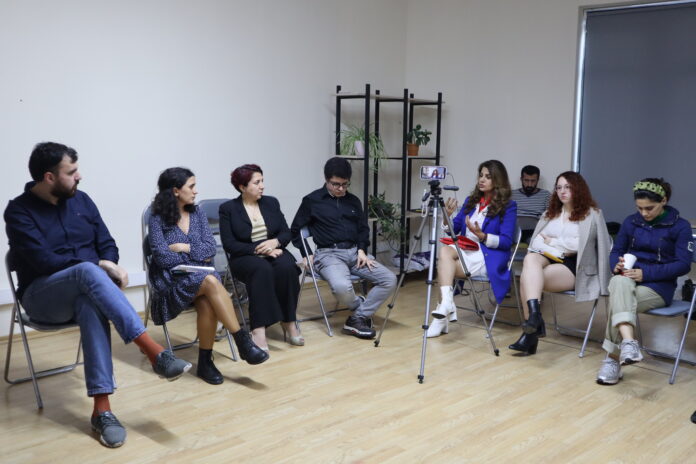“Baku/10/27/22/Turan: During a public discussion on “Discrimination and Inequality in
Women’s Representation” held by the “Article 54” Public Union on October 26, it was
emphasized that in Azerbaijan, women are predominantly engaged in the fields of
education and healthcare.”
The organization’s members engaged with 40 women from 5 regions across the
country, conducted discussions with diverse experts, and submitted inquiries to
governmental bodies to assess the situation in this field.
Citing data from the State Statistics Committee, it was highlighted that during 2020-
2021, women constituted 83 percent of the workforce in Azerbaijan’s education sector.
However, this predominance is primarily observed in regular positions. Notably, 64
percent of school principals are men, whereas women account for 36 percent. In higher
education institutions, despite 56 percent of teachers being women, women hold only
10 percent of rector positions while 90 percent are occupied by men. Additionally, 26
percent of deans are women compared to 74 percent being men.
The event’s organizers conveyed that within the context of employment in Azerbaijan,
48 percent are women and 52 percent are men. In contrast, within the unemployed
population, 57 percent are women and 43 percent are men. Turning to the judicial
sector, it was revealed that 83 percent of judges are men, leaving women at 17 percent.
Recent years’ data similarly indicates a pronounced male majority within the state
administration.
Abulfaz Gurbanli, the head of the organization, noted that despite numerous appeals
from international organizations regarding women’s representation in Azerbaijan, the
situation remains largely unchanged. He emphasized that the issue is not merely about
a participatory process but rather concerns representation within both state institutions
and the private sector. While there has been some increase in the number and presence
of women in municipal bodies, their roles remain primarily auxiliary, lacking substantial
functional engagement.
Aygul Jafarova, a member of the organization, pointed out that the Global Gender Index
report, released in July of the current year, consists of four key parameters: women’s
access to education, healthcare, economic opportunities, and political participation. She
highlighted that Azerbaijan is ranked 101st out of 146 countries in this report.
She also noted that a similar pattern is evident in other institutions, which ultimately
contributes to the economic dependence of women.
Economist Togrul Valiyev highlights that international organizations have reported a
potential GDP increase of 1-2 percent resulting from women’s increased participation.
He underscores that Azerbaijan faces significant challenges in this area, observing that
while women are well-represented across various sectors, they remain
underrepresented in politics and economics. This situation has unfortunate
consequences, pushing some women towards engaging in illegal activities. Notably, 60
percent of women are involved in individual entrepreneurship, many of whom are
compelled to resort to illegal practices due to hindrances to their direct involvement.
This, in turn, contributes to a rise in unemployment rates.
The expert further notes that in Azerbaijan, women are often not regarded as heads of
families, leading them to predominantly occupy low-income positions due to such
stereotypes.
According to perspectives shared by other event participants, men overwhelmingly hold
leadership positions across virtually all sectors within the country, leaving a substantial
portion of women confined to household roles. This stark division is exacerbated by the
fact that women often receive lower pay, leading to their vulnerability and exploitation.
During the event, participants actively deliberated on potential pathways to address and
rectify this pressing issue.
Recent years’ data similarly indicates a pronounced male majority within the state
administration.
Abulfaz Gurbanli, the head of the organization, noted that despite numerous appeals
from international organizations regarding women’s representation in Azerbaijan, the
situation remains largely unchanged. He emphasized that the issue is not merely about
a participatory process but rather concerns representation within both state institutions
and the private sector. While there has been some increase in the number and presence
of women in municipal bodies, their roles remain primarily auxiliary, lacking substantial
functional engagement.
Aygul Jafarova, a member of the organization, pointed out that the Global Gender Index
report, released in July of the current year, consists of four key parameters: women’s
access to education, healthcare, economic opportunities, and political participation. She
highlighted that Azerbaijan is ranked 101st out of 146 countries in this report.
She also noted that a similar pattern is evident in other institutions, which ultimately
contributes to the economic dependence of women.
Economist Togrul Valiyev highlights that international organizations have reported a
potential GDP increase of 1-2 percent resulting from women’s increased participation.
He underscores that Azerbaijan faces significant challenges in this area, observing that
while women are well-represented across various sectors, they remain
underrepresented in politics and economics. This situation has unfortunate
consequences, pushing some women towards engaging in illegal activities. Notably, 60
percent of women are involved in individual entrepreneurship, many of whom are
compelled to resort to illegal practices due to hindrances to their direct involvement.
This, in turn, contributes to a rise in unemployment rates.
The expert further notes that in Azerbaijan, women are often not regarded as heads of
families, leading them to predominantly occupy low-income positions due to such
stereotypes.
According to perspectives shared by other event participants, men overwhelmingly hold
leadership positions across virtually all sectors within the country, leaving a substantial
portion of women confined to household roles. This stark division is exacerbated by the
fact that women often receive lower pay, leading to their vulnerability and exploitation.
During the event, participants actively deliberated on potential pathways to address and
rectify this pressing issue.


